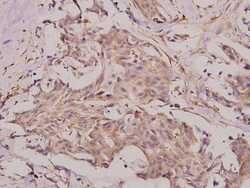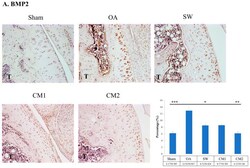Antibody data
- Antibody Data
- Antigen structure
- References [1]
- Comments [0]
- Validations
- Immunohistochemistry [1]
- Other assay [1]
Submit
Validation data
Reference
Comment
Report error
- Product number
- PA5-75427 - Provider product page

- Provider
- Invitrogen Antibodies
- Product name
- BMP-6 Polyclonal Antibody
- Antibody type
- Polyclonal
- Antigen
- Synthetic peptide
- Description
- The antibody was affinity-purified from rabbit antiserum by affinity-chromatography using epitope-specific immunogen and the purity is > 95% (by SDS-PAGE).
- Reactivity
- Human, Mouse, Rat
- Host
- Rabbit
- Isotype
- IgG
- Vial size
- 100 μL
- Concentration
- 1 mg/mL
- Storage
- Store at 4°C short term. For long term storage, store at -20°C, avoiding freeze/thaw cycles.
Submitted references Adipose-Derived Mesenchymal Stem Cells-Conditioned Medium Modulates the Expression of Inflammation Induced Bone Morphogenetic Protein-2, -5 and -6 as Well as Compared with Shockwave Therapy on Rat Knee Osteoarthritis.
Cheng JH, Hsu CC, Hsu SL, Chou WY, Wu YN, Kuo CA, Hsu TC, Shiu LY, Jhan SW
Biomedicines 2021 Oct 5;9(10)
Biomedicines 2021 Oct 5;9(10)
No comments: Submit comment
Supportive validation
- Submitted by
- Invitrogen Antibodies (provider)
- Main image

- Experimental details
- Immunohistochemistry analysis of BMP-6 in paraffin-embedded human breast carcinoma tissue. Samples were incubated with BMP-6 polyclonal antibody (Product # PA5-75427) at a dilution of 1:100.
Supportive validation
- Submitted by
- Invitrogen Antibodies (provider)
- Main image

- Experimental details
- Figure 6 Immunohistochemical analysis for ( A ) BMP2, ( B ) BMP5, and ( C ) BMP6 (x400 magnification), and the percentage of BMP2, BMP5, and BMP6 expression in the articular cartilage of the tibia for each group is shown on the left. The 100 and 200 muL adipose-derived mesenchymal stem cells-conditioned medium groups are indicated as CM1 and CM2, respectively. SW indicates shockwave. * p < 0.05, ** p < 0.01, and *** p < 0.001 as compared with the osteoarthritis (OA) group. Eight rats were used for each group.
 Explore
Explore Validate
Validate Learn
Learn Western blot
Western blot Immunohistochemistry
Immunohistochemistry